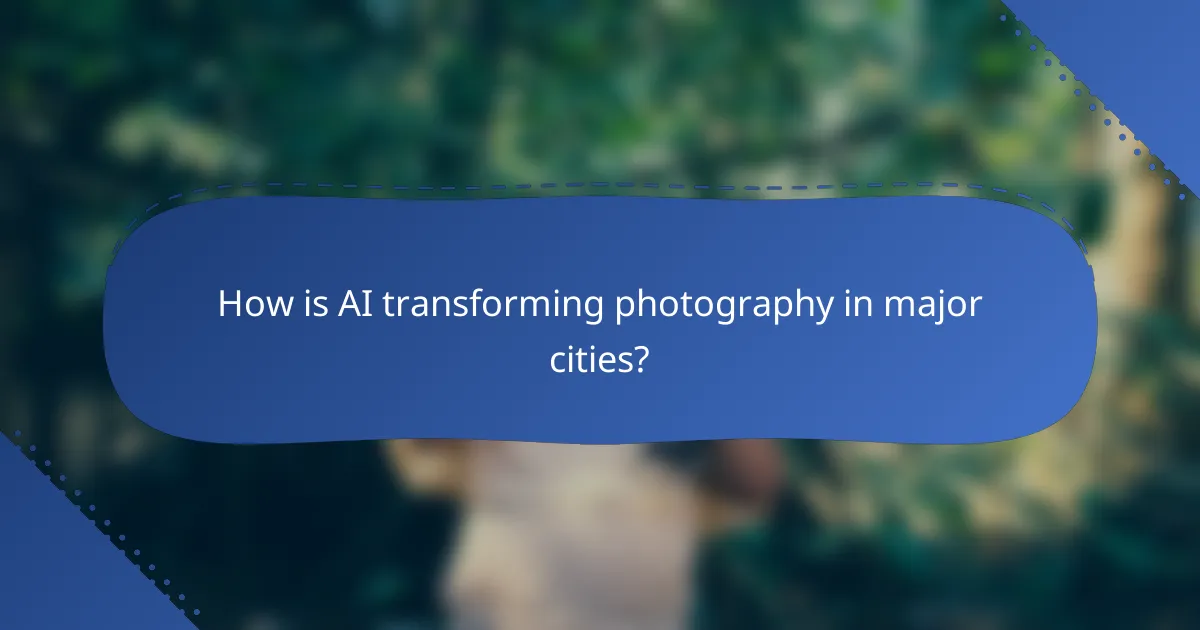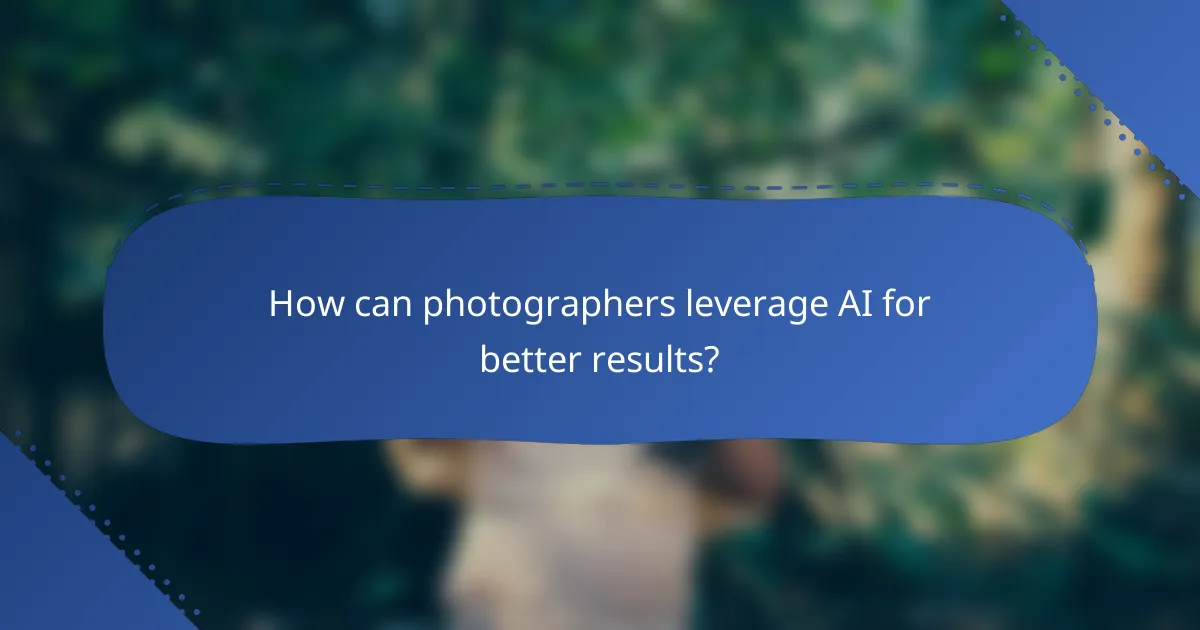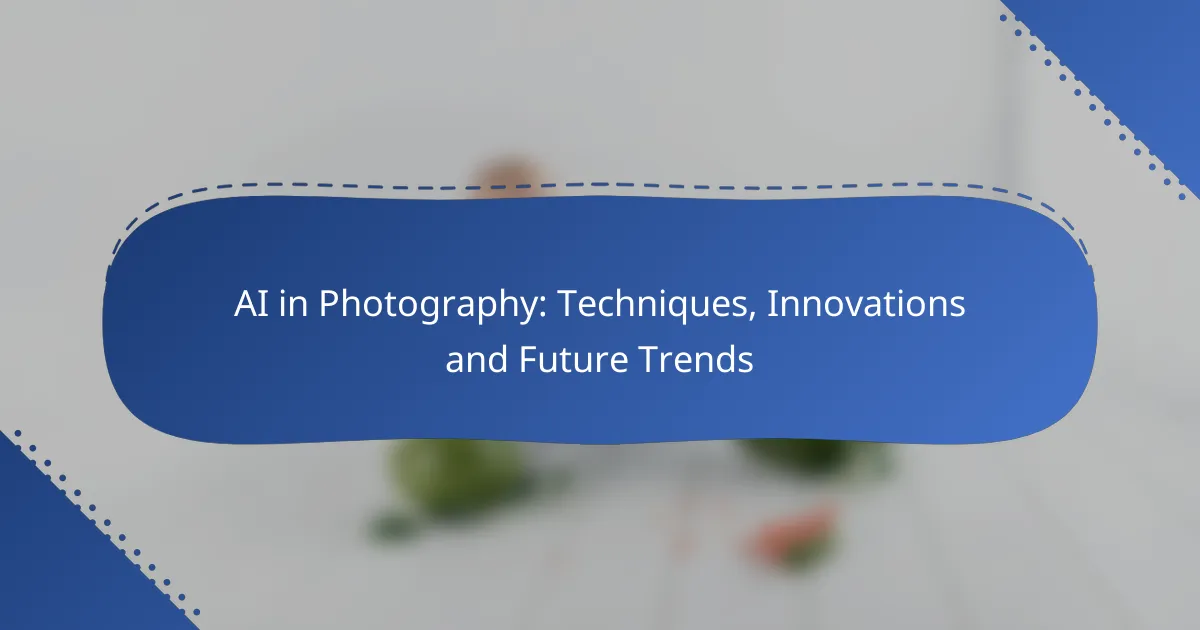AI is revolutionizing the field of photography by enhancing image quality, automating editing processes, and offering creative composition suggestions. With the integration of machine learning algorithms and computer vision applications, photographers can achieve stunning results more efficiently, adapting to the demands of modern urban environments. As AI tools continue to evolve, they are set to redefine the creative possibilities within photography.

How is AI transforming photography in major cities?
AI is significantly transforming photography in major cities by enhancing image quality, streamlining editing processes, and providing creative composition suggestions. These advancements allow photographers to produce high-quality images more efficiently and creatively, adapting to the fast-paced urban environment.
Enhanced image processing
AI-powered image processing tools improve the quality of photographs by automatically adjusting exposure, contrast, and color balance. These tools can analyze images and apply enhancements that would typically require extensive manual editing, saving photographers valuable time.
For instance, software like Adobe Photoshop now incorporates AI features that can intelligently remove noise or sharpen details, making it easier to achieve professional results. Photographers in cities can leverage these tools to quickly enhance images taken in challenging lighting conditions.
Automated editing tools
Automated editing tools utilize AI algorithms to perform repetitive tasks, such as cropping, straightening, and applying filters. This automation allows photographers to focus on more creative aspects of their work while ensuring that basic edits are completed efficiently.
Many platforms, such as Lightroom and Snapseed, now offer one-click editing options that can drastically reduce editing time, often transforming hours of work into mere minutes. This is particularly beneficial for urban photographers who need to process large volumes of images quickly for social media or client delivery.
AI-driven composition suggestions
AI-driven composition tools analyze images and provide suggestions for improving framing and layout. These tools can guide photographers in real-time, helping them make better decisions about angles and perspectives as they shoot in dynamic city environments.
Applications like Google Photos and various smartphone cameras now include features that suggest optimal cropping or highlight the rule of thirds, enhancing the overall visual appeal of images. Photographers can use these suggestions to create more engaging content that resonates with urban audiences.

What are the key AI techniques used in photography?
Key AI techniques in photography include machine learning algorithms, computer vision applications, and deep learning for image enhancement. These methods enhance image quality, automate processes, and enable innovative features in photography.
Machine learning algorithms
Machine learning algorithms analyze vast datasets of images to identify patterns and improve photography outcomes. They can automate tasks like tagging, sorting, and enhancing images based on learned preferences.
Common algorithms include decision trees, support vector machines, and neural networks. Each has its strengths, with neural networks often providing superior performance in complex tasks like image classification.
Computer vision applications
Computer vision applications utilize AI to interpret and understand visual information from the world. In photography, this can mean recognizing objects, faces, or scenes, which helps in automatic framing and focus adjustments.
For instance, many smartphones now feature AI-driven scene recognition that optimizes camera settings based on the detected environment, such as landscapes or portraits, enhancing overall image quality.
Deep learning for image enhancement
Deep learning techniques, particularly convolutional neural networks (CNNs), are pivotal for image enhancement. They can upscale images, reduce noise, and apply artistic styles, transforming ordinary photos into striking visuals.
Tools powered by deep learning, such as Adobe’s Super Resolution and various mobile apps, allow users to enhance images with minimal effort. However, users should be cautious of over-processing, which can lead to unnatural results.

Which AI tools are popular among photographers?
Popular AI tools among photographers enhance editing efficiency and creativity. These tools leverage machine learning to automate tasks, improve image quality, and provide innovative features that streamline the workflow.
Adobe Photoshop with AI features
Adobe Photoshop integrates AI through its Adobe Sensei technology, which automates complex tasks like object selection and image enhancement. Features such as Neural Filters allow photographers to apply artistic effects and make adjustments with minimal effort.
When using Photoshop’s AI capabilities, it’s essential to familiarize yourself with the interface and the specific tools available. For instance, the Sky Replacement tool can dramatically change the mood of a photograph in just a few clicks, saving time compared to manual edits.
Skylum Luminar AI
Skylum Luminar AI focuses on providing a user-friendly experience with its AI-driven editing tools. It offers features like AI Sky Enhancer and AI Structure, which intelligently adjust elements in an image without affecting the entire photo.
This software is particularly beneficial for photographers looking for quick results without sacrificing quality. The templates available can serve as starting points, allowing users to achieve professional-looking edits in a fraction of the time.
Topaz Labs AI tools
Topaz Labs offers a suite of AI tools designed for specific tasks such as noise reduction, sharpening, and upscaling images. Tools like Topaz DeNoise AI and Topaz Sharpen AI utilize advanced algorithms to enhance image clarity and detail while preserving the original quality.
These tools are ideal for photographers who often work with low-light images or require high-resolution outputs. However, users should be cautious about over-processing images, as excessive adjustments can lead to unnatural results. A good practice is to compare before-and-after images to ensure the edits enhance rather than detract from the original work.

What innovations are emerging in AI photography?
Emerging innovations in AI photography are transforming how images are captured, edited, and shared. Key advancements include generative adversarial networks (GANs), real-time photo adjustments, and smartphone AI enhancements, all aimed at improving image quality and user experience.
Generative adversarial networks (GANs)
Generative adversarial networks (GANs) are a groundbreaking technology in AI photography that enables the creation of highly realistic images. GANs consist of two neural networks, a generator and a discriminator, that work against each other to produce images that can be indistinguishable from real photographs.
These networks can be used for various applications, such as enhancing image resolution, generating new artistic styles, or even creating entirely new images from scratch. For photographers, GANs can serve as powerful tools for creative exploration and experimentation.
AI for real-time photo adjustments
AI technology now allows for real-time adjustments to photos, enhancing images as they are taken. This includes automatic exposure correction, color balancing, and noise reduction, which can significantly improve the quality of images captured in challenging lighting conditions.
For instance, many modern cameras and smartphones utilize AI algorithms to analyze scenes and optimize settings instantly. This capability helps photographers focus on composition rather than technical settings, making photography more accessible to beginners.
Smartphone AI photography advancements
Smartphones have seen significant advancements in AI photography, making high-quality imaging available to a broader audience. Features like portrait mode, night mode, and scene recognition leverage AI to enhance photo quality without requiring extensive knowledge of photography techniques.
These innovations often include computational photography techniques that combine multiple images to create a single, high-quality photo. Users can benefit from these features by exploring their smartphone’s camera settings and taking advantage of built-in AI tools for better results.

How can photographers leverage AI for better results?
Photographers can leverage AI to enhance their results by automating tedious tasks, improving client interactions, and expanding creative opportunities. By integrating AI tools into their workflow, photographers can save time and focus more on their artistic vision.
Streamlining workflows
AI can significantly streamline photography workflows by automating repetitive tasks such as image sorting, tagging, and editing. Tools like Adobe Lightroom and Capture One now incorporate AI features that can analyze images and suggest edits, saving hours of manual work.
For example, AI-driven software can quickly categorize thousands of photos based on content, allowing photographers to locate specific images in a matter of seconds. This efficiency not only enhances productivity but also enables photographers to manage larger projects without feeling overwhelmed.
Improving client engagement
AI can enhance client engagement by personalizing communication and providing tailored experiences. Chatbots powered by AI can handle inquiries and bookings, ensuring clients receive immediate responses, which improves satisfaction and retention.
Additionally, AI can analyze client preferences and past interactions to suggest specific services or packages. This personalized approach can lead to increased sales and stronger relationships, as clients feel understood and valued.
Enhancing creative possibilities
AI opens up new creative possibilities for photographers by offering innovative tools for image manipulation and enhancement. For instance, AI algorithms can generate unique styles or effects that would be time-consuming to achieve manually, allowing photographers to experiment with their work.
Moreover, AI can assist in generating ideas for shoots by analyzing trends and suggesting themes based on current market demands. This capability enables photographers to stay ahead of the curve and produce work that resonates with their audience.

What are the ethical considerations of AI in photography?
The ethical considerations of AI in photography revolve around issues such as copyright, authenticity, and the potential for misuse. As AI tools become more sophisticated, they raise important questions about ownership and the integrity of photographic work.
Copyright issues
Copyright issues in AI photography primarily concern the ownership of images generated or altered by AI systems. When an AI creates a photograph, it can be unclear who holds the copyright—the developer of the AI, the user, or the original content that trained the AI.
In many jurisdictions, copyright law may not yet fully address AI-generated content, leading to potential disputes. For example, if an AI uses existing photographs to generate new images, the original photographers may claim rights over the derivative works, complicating the legal landscape.
To navigate these issues, photographers should consider documenting the creation process and obtaining permissions for any source material used in AI training. Keeping clear records can help clarify ownership and reduce the risk of legal challenges.
